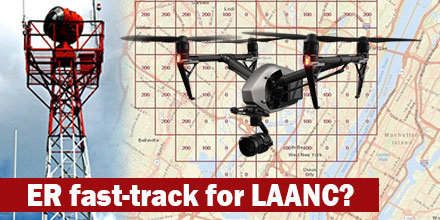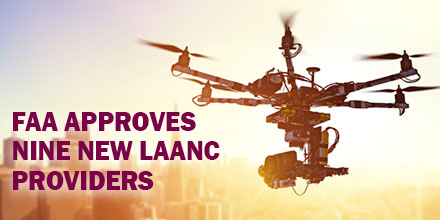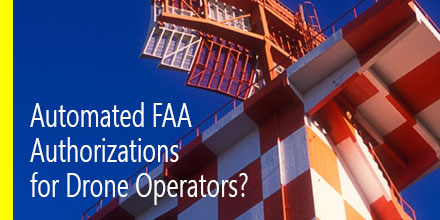
It seems the Federal Aviation Administration (FAA) finally reached a breaking point with requests to access restricted airspace.
Currently, it can take up to 90-days for an operator to get authorization to navigate controlled airspace. With more and more authorization requests pouring in, the logjam continues to get worse.
As such, the speculation is that some operators decide not to wait and fly without authorization. This may explain the increase in the number of non-compliant operations, as reported by the FAA. It is estimated that there are over 250 drone-related safety reports each month.
Access to restricted airspace
Under
14 CFR 107.41, “no person may operate a small unmanned aircraft in Class B, Class C, or Class D airspace or within the lateral boundaries of the surface area of Class E airspace designated for an airport unless that person has prior authorization from Air Traffic Control (ATC).”
Since Part 107 launched, the FAA has received an extremely high volume of airspace authorization requests from UAS operations. From September 2016 to July 2017 the Agency received 20,566 authorization requests. Of these, the Agency processed 14,334.
At any given time, there are up to 6,000 authorizations in the processing queue. Additionally, the number of requests continue to increase. The FAA expects the queue will exceed 25,000 pending authorizations within the next 6 months.
Ongoing efforts by the FAA
The solution? Fast-track the electronic authorization of drone flights. The groundwork for this eventuality has been a work-in-progress for the FAA.
The first step came when the FAA implemented Part 107 in August 2016.
This year, the FAA – in collaboration with airport tower staff – developed and published a series of grids. These grids depict the maximum safe and permissible altitude for unmanned aircraft operations. The FAA published these maps online.
The maps serve as the foundation for the Low Altitude Authorization and Notification Capability (LAANC) system. The goal is for LAANC to provide a quick and efficient response to airspace authorization requests.
Real-time authorizations with LAANC?
When operational, the FAA believes LAANC will help the agency grant “near-real time" authorizations for the vast majority of operations. The FAA states that remote pilots certified under part 107, who submit requests that comport with the published limitations, can expect almost real-time, electronic approval.
The system is also vital to the safety of National Airspace. The FAA expects LAANC to reduce “non-compliant” operations by at least 30 percent. Plus, once operational, it reduces distraction of controllers working in the Tower.
The FAA’s recent request seeks to accelerate the implementation of LAANC, which was to take until the end of the year.
“Due to the pressing safety consideration of reducing safety reports due to non-compliant UAS operations, the FAA cannot wait the normal 90 days of public comment,” the agency stated in the Federal Register notice Oct. 11. “Therefore, FAA is requesting Office of Management and Budget's (OMB) approval of this collection of information 7 days after publication of this Notice in the Federal Register. Upon OMB approval of its Emergency clearance request, FAA will follow the normal clearance procedures for the information collection associated with LAANC.”
 The Federal Aviation Administration (FAA) announced nine new partners to its Low Altitude Authorization and Notification Capability (LAANC) initiative.
LAANC is an innovative collaboration between the FAA and the drone industry.
The initiative provides near real-time processing of airspace authorizations for Part 107 drone operators nationwide who fly in controlled airspace.
The Federal Aviation Administration (FAA) announced nine new partners to its Low Altitude Authorization and Notification Capability (LAANC) initiative.
LAANC is an innovative collaboration between the FAA and the drone industry.
The initiative provides near real-time processing of airspace authorizations for Part 107 drone operators nationwide who fly in controlled airspace.

 It seems the Federal Aviation Administration (FAA) finally reached a breaking point with requests to access restricted airspace.
Currently, it can take up to 90-days for an operator to get authorization to navigate controlled airspace. With more and more authorization requests pouring in, the logjam continues to get worse.
As such, the speculation is that some operators decide not to wait and fly without authorization. This may explain the increase in the number of non-compliant operations, as reported by the FAA. It is estimated that there are over 250 drone-related safety reports each month.
It seems the Federal Aviation Administration (FAA) finally reached a breaking point with requests to access restricted airspace.
Currently, it can take up to 90-days for an operator to get authorization to navigate controlled airspace. With more and more authorization requests pouring in, the logjam continues to get worse.
As such, the speculation is that some operators decide not to wait and fly without authorization. This may explain the increase in the number of non-compliant operations, as reported by the FAA. It is estimated that there are over 250 drone-related safety reports each month.
 By the end of the year, several airports are expected to offer automated authorization for drone operators in controlled airspace. The rest of the nation’s airports will follow suit in 2018.
If successful, these automated authorizations will remove a significant barrier to the rapid expansion of commercial UAS operations.
Today, flights in controlled airspace, at certain times of day, or near sensitive locations require authorization from the FAA. Authorization requests can take up to 90 days and require labor-intensive manual approvals.
Today in
By the end of the year, several airports are expected to offer automated authorization for drone operators in controlled airspace. The rest of the nation’s airports will follow suit in 2018.
If successful, these automated authorizations will remove a significant barrier to the rapid expansion of commercial UAS operations.
Today, flights in controlled airspace, at certain times of day, or near sensitive locations require authorization from the FAA. Authorization requests can take up to 90 days and require labor-intensive manual approvals.
Today in 